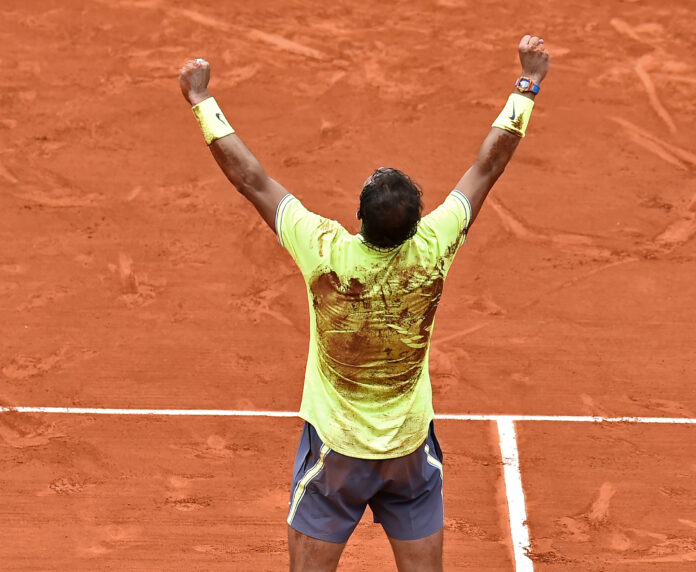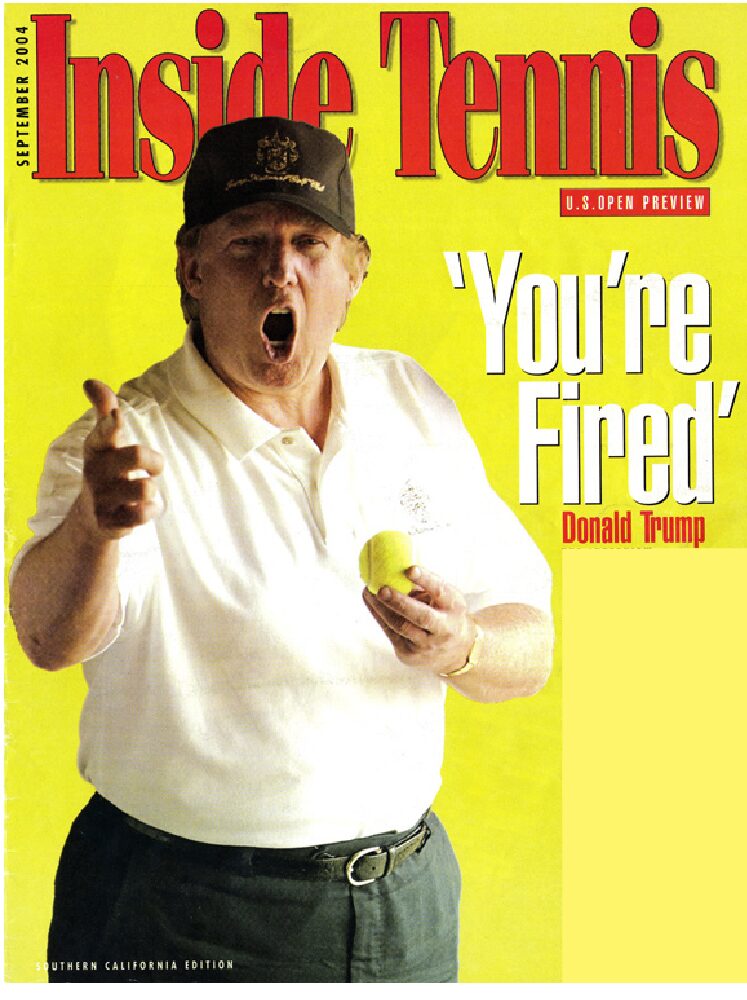Bill Simons
It was bound to come – the day when the 38-year-old King of Clay, with his 14 French Open titles and 22 Slams, would be calling it a day.
On October 10th, Rafa Nadal announced that after 21 glorious and most muscular seasons, he’d be retiring after he plays Davis Cup for Spain in late November.
With his announcement, we were quick to recall when he first emerged as a teenage phenom in 2004 playing Davis Cup in a packed soccer stadium in Seville before 27,4OO elated fans. And we still can picture the dusk of one July Wimbledon evening when Nadal managed to rebuff Federer in the greatest tennis match of all time.
Plus, we remembered a day at Roland Garros in 2022 when word got out that Rafa would be playing on Court Suzanne Lenglen.
This would be like getting to hear Paul McCartney singing at your local cafe.
Court Lenglen is a celebration of intimacy – and has the best press seats in the world – just 20 yards from the gorgeous clay court that’s nothing less than a silken tapestry.
Watching any master up close is a privilege. You feel you have to relish every moment, catch every nuance and embed it in your memory. Just below me, from the third row of the press box, was an ode to athletic power. In Rafa we see a linebacker in sneakers. His focus doesn’t waver. He relentlessly explodes into his shots. His muscularity is fluid.
Of course, we note his rituals: kicking the clay off his Nikes, tugging his shirt, tapping his face, pulling at his wedgies. Up close, Rafa’s bald spot seems bigger, his fist pumps to his box are more intense. Between points, his strides have a no-nonsense military intent. His ferocity shouts loud. He glares at a fan in a red Emirates hat who arrives late. His stare shouts: “How dare you disturb my stage!” Shot after shot, his primordial grunt fills the French air – “Oohh-ahhh!”
But it’s his athleticism that mesmerizes. It’s said that the hardest thing to do in tennis is to beat Nadal on clay in five sets. The only winning strategy is to hit all your shots on the line.
This mighty hunk has the whole package: laser backhand, seamless defense, surgical focus, clear intent, Nadalian aura, and uncanny anticipation. Mary Carillo once asked, “Have you ever seen anyone who has the same sense of recognition of the rhythms of a clay court match?”
Nadal’s underrated and vastly improved serve is not as gorgeous as Federer’s. It’s not as distinctive as McEnroe’s or as fluid as Edberg’s. It’s not nearly as imposing as Isner’s, as classic as Sampras’s or as flawless as Pancho Gonzales’s. Still, it has a certain toss-and-blast grace.
But it’s Rafa’s whiplash forehand that is his signature. No one has ever hit a forehand quite like this man. It’s an explosion that hisses. Cross-court or down-the-line, returning serve or deep into a marathon rally, it dips within inches of the baseline – an uppercut with topspin that drains the will out of his foes. “It has so many RPMs on it that it creates its own wind,” noted Brett Haber.
His foe this afternoon, Botic Van de Zandsculp, said, “Rafa plays differently from the others. The ball comes differently. He gives you the feeling you have to win the point six, seven times…You have to play a perfect game…Even when you go hard to the floor, he easily redirects it down the line….He didn’t let go. It’s frustrating when you hit good shots and he still gets the balls back.”
After his win, Nadal is asked what it shows that he has so many records. He joked, “It shows that I’m old.” He added, “I couldn’t live without the special things tennis has given to me, playing in the best stadiums of all the world.”
Of course, it is Rafa who has given so much. As the sun begins to dip, Lenglen’s orange carpet takes on a golden hue. I ask myself, “Can watching a tennis player be a spiritual experience? “Heavens, no,” I think. Then I think again.
TOP TEN REASONS WE LOVE RAFA
1. WHAT A BODY: Bulging biceps, thighs to kill for, a hunky chest that impresses, Rafa’s body is a marvel. His muscles have muscles. Too bad that, like a problematic Ferrari, his chassis was in the shop far too often.
2. WICKED WEAPONRY: Nadal’s topspin forehand has everything: speed, spin, variety, weight. It pins, it flicks winners, it punishes susceptible backhands. It’s a jab, an uppercut, a knockout punch. Jim Courier contended, “The pace he generates when he’s moving away from his target is just ridiculous…It’s a little bit unfair to have that much power and finesse.”
Many claimed Nadal’s forehand was the best in the game – period.
All the while, Rafa’s volleys are daggers. At key times he has upgraded his serve. His backhand is a laser. Aussie Darren Kane said that Rafa “positively bludgeons his backhand in the same way I’d attack a to-be-demolished wall with a sledgehammer.”
3. THE KING OF CLAY: Time and again we’ve seen him on a Sunday afternoon spread-eagled on an orange court, coated in clay, his back on the ground, his eyes gazing into the heavens. Once again he’s celebrating another topspin-happy triumph on European dirt. One year, after he’d again cannonballed his way through the clay court circuit, Rafa said, “What happened in Monte Carlo happened. What happened in Barcelona happened. What happened in Madrid happened. And here we are in Rome.”
No one has dominated a surface like the king of clay. He’s won 14 French Opens and has a record there of 112-4. He has a 474-45 mark on clay. He once won 81 straight clay matches, and he’s prevailed at 63 clay tourneys. For years, everyone knew that beating Rafa in a best-of-five clay court match was the hardest thing to do in sports.
4. RAFA’S RITUALS HAVE RITUALS: Nadal confided, “I’m lost if I don’t have my rituals.”
The man tells us he doesn’t like to sleep because he considers it a waste of time. He leaps up and down like a yoyo in entry corridors before emerging into tennis arenas and then dashes madly to the baseline. With Rafa, flicks and twitches morph into an art form. He fusses over his hair. He pulls at his wedgies and, of course, meticulously arranges his water bottles, then rearranges them with surgical precision.
It’s said that, “Nadal likes two water bottles placed at his right foot…he always drinks the bottle on the left side first, and places them delicately back in the same spot when he’s finished.” Rarely has a such an imposing athlete displayed such delicacy. Aussie Todd Woodbridge noted that once Rafa stops playing, “he’ll be very good at housework. His sock drawer will be in order.”
And let’s not forget one of the key stats in the game: Rafa’s foes are 0-2 after intentionally tipping over one of his precious bottles. In Rafa’s early years he sported long pirate pants and breezy shirts that showcased his Popeye-worthy muscularity. Christopher Clarey noted that Rafa “was wearing his emotions on his sleeve, which would have been an appropriate metaphor if he had not worn a sleeveless shirt.”
5. RAFA-ISMS: At times, Nadal’s English seems like it’s going off the rails. Then he seamlessly makes inspired, almost poetic, corrections. His “Rafa-isms” are unique. He once told us, “I was just trying to not do something very good, but not doing something very bad.” He informed us, “When you take decisions, you have mistakes or you don’t.”
But don’t be fooled – Rafa’s a reflective thinker. He told Inside Tennis, “Doubts are a part of this life. Doubts are good. I doubt about myself. Persons who don’t have doubts are arrogant or not intelligent.”
He says, “My job is to find myself.” And what about the big picture? Does he believe in God? He mused, “It’s hard to say, ‘I don’t believe in God,’ But it’s very difficult for me to believe…If God exists, he’s intelligent enough to do the important things, the right things.”
6. RELENTLESS COMMITMENT: No one hits a tennis ball with more intent. No one stays in every single point like Rafa. He runs down everything. He never surrenders.
Time and again, he has battled injuries to save his career. Uncle Toni recalled, “When he was young, every practice was like a final. [He] can’t understand life without this commitment…It’s the most important thing in life…His father told him, ‘You don’t have to go for that ball because you cannot arrive,’ and he said, ‘No, no, no – it is better to go for it.’”
Toni explained the essence of commitment: “The inspiration has to be in the work. It’s the same for a painter, a sportsman, a journalist – for everyone.”
7. WILL, FURY, AND PAIN: Rafa’s symbol is the bull, but he’s a lion, too. He pounces. His don’t-tread-on-me defense withers foes. This man’s fury and unblinking intensity are his essence. The Tennis Channel said that Rafa “needs the pain, he needs the conflict, he needs the antagonistic nature of competition.”
After being pummeled by Nadal, Stefanos Tsitsipas confided, “My brain was used to certain angles. But tonight against Rafa I was always on the wrong foot…He has a talent to make you play bad…I felt empty in the brain.”
8. THE RIVALRY: The battles between Martina Navratilova and Chris Evert were something else. Rafa and Djokovic faced off 60 times. Still, there was nothing like the Nadal-Federer rivalry. Their battles always sizzled and their 2008 “Strokes of Genius” Wimbledon final was the greatest match of all time.
The duo gave us a mosaic of gifts: will and fury, beauty and grace. Throngs gathered to relish these athletic gods. Some traveled thousands of miles just to see them practice. Poets and sages sang their praises.
At one point when Roger and Rafa had won 21 of 23 Slams, John McEnroe joked they were “nasty, stingy people. They are not sharing a lot of majors.” Ion Tiriac commented that Roger plays the piano on court while Rafa plays the drums. Federer’s trainer, Pierre Paganini, suggested that Rafa was “a fighter who became an artist, while Roger was an artist who became a fighter.”
While reflecting on Federer, Nadal said, “There are just two things we probably share…passion for the competition, and the spirit of improvement all the time.”
For his part, Federer noted that he would have had an amazing clay court career if Rafa hadn’t been around…”There will never be a rivalry like ours.” He advised Rafa, “Keep playing – tennis needs you.”
Christopher Clarey contended, “if you haven’t seen Federer or Nadal play, you have not lived 21st-century life to the fullest.”
9. HE’S GOT GAME: There’s a reason Rafa has won 22 Slams. Nadal’s fitness advisor, Angel Cotorro, said he “mixes the explosive pace of a 200-meter sprinter with the resistance of a marathon runner.” The Tennis Channel added, “You have to have a protractor to figure out the angles Rafa is getting.” Federer admitted, “Nadal’s game is so unique that I can’t find a practice partner to replicate it.”
Jim Courier said, “Rafa is the best pure competitor in men’s tennis…In the end, he’s not into the perfection business, he’s into the winning business.” He suggested that Rafa’s force brings to mind what they said about boxer Mike Tyson: “Everyone has a plan until they get punched in the face.”
When it comes to fierce desire combined with sublime skill, Nadal is in the same conversation with Tiger Woods, Tom Brady, Pete Rose, Wayne Gretzky, Lionel Messi, Bill Russell, Michael Jordan, Kobe, Serena and Lebron.
10. A GENTLE, HUMBLE WARRIOR: John McEnroe asked, “How can someone like Rafa be so humble and cocky at the same time?” Nadal always had perspective, and left his combative ferocity on the court. After a wretched Wimbledon loss, he said, “I tried. I lost. It’s not a drama.”
As for the desire to have all the records, Rafa insisted, “You can’t be frustrated…because the neighbor has a bigger house or TV or a better garden. That’s not the way that I see life.”
Jon Wertheim reported that he heard one security guard in the US Open players’ lounge tell his partner, “There’s the guy who’s always saying thank you.” His friend replied, “Yeah, that’s Rafa Nadal.”
Has a superstar ever been so humble?
THE RAFA QUOTEBOOK
“Even at this late stage, Nadal plays like he’s broke.” – Jimmy Connors
“The whiff of sporting mortality has done something to Nadal. He’s learnt how fragile and brief is a career in sport…There’s a hymn we used to sing that encouraged us to live each day as if it were our last. All this year Nadal has played each point as if it were his last.” – Simon Barnes in the London Times about a decade ago
“He’s half-bull, half-bullfighter. Rafa displays an on-court, testosterone-driven truculence that might be expected to limit affection for him. But his myriad supporters revere him for his relentless effort and refusal to quit.” – Michael Mewshaw
“Rafa is Hamlet. He has more questions than answers. His implacable force has gone missing, maybe forever…For the first time, it’s possible to imagine him never winning another major.” – Sports Illustrated about a decade ago. But forget that. Since then, Nadal won eight slams, an Olympic gold medal and a Davis Cup Championship.





















